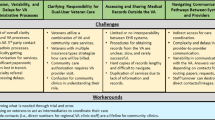Abstract
Many rural Veteran patients receive healthcare services from both Veterans Affairs (VA) and non-VA providers. Effective management of dual care Veteran patients to ensure the best clinical outcomes is a VA mission. The previous VA studies indicate that coordination between VA and non-VA providers has been lacking for dual care management of Veteran patients. In this study, we propose that VA proactively shares information with non-VA providers to enhance the communication process and identify the best practices to be carried out by both VA and non-VA providers for better coordination. Structured questionnaires are designed and distributed to VA and non-VA providers to obtain their evaluations on the proposed VA proactive information sharing approaches and the best practice items for dual care management. The non-VA provider respondents largely support the proposed proactive sharing items by VA, with the lowest average score being 3.96 out of a 5.0 scale on one item. In terms of the best practice items on co-managing dual care patients, three out of five items are overall rated higher than 4.0 from both sides. A pair-wise comparison between VA and non-VA perspectives further shows that the difference in average ratings of a proposed item could be significant. For such best practice items, the implementations from both sides may not be most effective.


Similar content being viewed by others
References
Veterans Health Administration Directive 2009-038, (2009). VHA national dual care policy, http://www.va.gov/vhapublications/ViewPublication.asp?pub_ID=2058, accessed October 10, 2012.
Lampman, M. A., & Mueller, K. J. (2011). Experiences of rural non-VA providers in treating dual care Veterans and the development of electronic health information exchange networks between the two systems. Journal of Rural Social Sciences, 26(3), 201–219.
Liu, C. F., Bolkan, C., Chan, D., et al. (2009). Dual use of VA and non-VA services among primary care patients with depression. Journal of General Internal Medicine, 24(3), 305–311.
Liu, C. F., Chapko, M., Bryson, C. L., et al. (2010). Use of outpatient care in Veterans Health Administration and Medicare among Veterans receiving primary care in community-based and hospital outpatient clinics. Health Services Research, 45(5 Pt 1), 1268–1286.
Nayar, P., Apenteng, B., Yu, F., et al. (2013). Rural Veterans’ perspectives of dual care. Journal of Community Health, 38(1), 70–77.
Hynes, D. M., Koelling, K., Stroupe, K., et al. (2007). Veterans’ access to and use of Medicare and Veterans affairs health care. Medical Care, 45, 214–223.
Gulliford, M., Naithani, S., & Morgan, M. (2006). What is continuity of care? Journal of Health Services Research & Policy, 11(4), 248–250.
Borowsky, S. J., & Cowper, D. C. (1999). Dual use of VA and non-VA primary care. Journal of General Internal Medicine, 14, 274–280.
Wolinsky, F. D., Miller, T. R., An, H., et al. (2006). Dual use of Medicare and the Veterans Health Administration: Are there adverse health outcomes? BMC Health Service Resource, 6(1), 131.
Carey, K., Montez-Rath, M., Rosen, A., et al. (2008). Use of VA and Medicare services by dually eligible Veterans with psychiatric problems. Health Services Research, 43(4), 1164–1183.
Kramer, B. J., Vivrette, R. L., Satter, D. E., et al. (2009). Dual use of Veterans health administration and Indian Health Service: Healthcare provider and patient perspectives. Journal of General Internal Medicine, 24(6), 758–764.
Grosse, S. D., Schechter, M. S., Kulkarni, R., et al. (2009). Models of comprehensive multidisciplinary care for individuals in the United States with genetic disorders. Pediatrics, 123(1), 407–412.
Hohmann, C., Neumann-Haefelin, T., Klotz, J. M., et al. (2013). Adherence to hospital discharge medication in patients with ischemic stroke A prospective, interventional 2-phase study. Stroke, 44(2), 522–524.
Hume, A. L., Kirwin, J., Bieber, H. L., et al. (2012). Improving care transitions: Current practice and future opportunities for pharmacists. Pharmacotherapy: The Journal of Human Pharmacology and Drug Therapy, 32(11), e326–e337.
Nayar, P., Nguyen, A. T., Ojha, D., et al. (2013). Transitions in dual care for Veterans: Non-federal physician perspectives. Journal of Community Health, 38(2), 225–237.
Acknowledgments
This research, in its entirety, was designed and conducted as a VA quality improvement activity. Funding was provided by the Department of Veterans Affairs; Veterans Health Administration; MidWest Mountain Veterans Engineering Resource Center (MWM VERC). Partial graduate research assistantship was also provided by National Science Foundation (Award #1126570). The views expressed herein and the recommendations made and conclusions drawn are those of the authors and do not necessarily reflect the position or policy of the United States government or any of its agencies.
Author information
Authors and Affiliations
Corresponding author
Rights and permissions
About this article
Cite this article
Shi, J., Peng, Y., Erdem, E. et al. Communication Enhancement and Best Practices for Co-Managing Dual Care Rural Veteran Patients by VA and Non-VA Providers: A Survey Study. J Community Health 39, 552–561 (2014). https://doi.org/10.1007/s10900-013-9797-3
Published:
Issue Date:
DOI: https://doi.org/10.1007/s10900-013-9797-3



